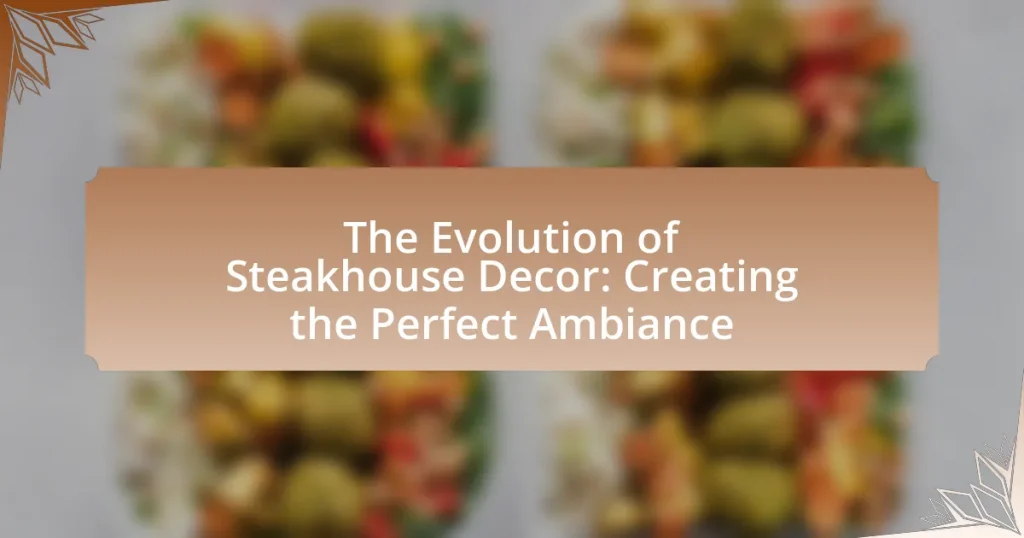The article examines the evolution of steakhouse decor, highlighting how it has transformed over the decades in response to changing dining trends and cultural influences. Initially characterized by rustic designs with wood and leather, steakhouses have shifted towards more sophisticated and contemporary styles, incorporating modern elements such as open kitchens and minimalist decor. Key factors influencing this evolution include historical influences, the importance of ambiance in enhancing customer experience, and the role of color schemes and lighting in creating inviting environments. The article also discusses best practices for optimizing steakhouse decor to achieve the perfect ambiance, emphasizing the significance of furniture selection, artwork, and outdoor integration.

What is the Evolution of Steakhouse Decor?
The evolution of steakhouse decor reflects changing dining trends and cultural influences over time. Initially, steakhouses featured rustic, simple designs emphasizing wood and leather to create a warm, inviting atmosphere, often inspired by traditional American ranch aesthetics. As the 20th century progressed, particularly in the post-World War II era, steakhouses began to adopt more sophisticated decor, incorporating elements like dark woods, plush seating, and dim lighting to enhance the dining experience and convey a sense of luxury.
In recent decades, contemporary steakhouses have embraced diverse styles, integrating modern design elements such as open kitchens, minimalist decor, and vibrant artwork, catering to a younger clientele while maintaining a nod to classic steakhouse traditions. This shift reflects broader trends in the restaurant industry, where ambiance plays a crucial role in attracting customers and enhancing their overall dining experience.
How has steakhouse decor changed over the decades?
Steakhouse decor has evolved significantly over the decades, transitioning from traditional, dark wood interiors to more modern, open spaces with lighter color palettes and contemporary furnishings. In the mid-20th century, steakhouses often featured heavy, rustic decor with leather booths and dim lighting, reflecting a classic American dining experience. By the 1980s and 1990s, many establishments began incorporating elements of fine dining, such as elegant table settings and artful decor, to enhance the overall dining experience.
In recent years, the trend has shifted towards a more casual and inviting atmosphere, with an emphasis on sustainability and local materials, as seen in the use of reclaimed wood and eco-friendly design elements. This change reflects broader societal shifts towards health consciousness and environmental awareness. For example, many modern steakhouses now feature open kitchens and communal dining spaces, fostering a sense of community and transparency in food preparation.
What historical influences shaped early steakhouse decor?
Early steakhouse decor was significantly shaped by the Victorian era’s emphasis on opulence and the American West’s rustic charm. The Victorian influence introduced ornate furnishings, rich fabrics, and intricate woodwork, reflecting the era’s wealth and social status. In contrast, the American West contributed elements like exposed brick, wooden beams, and cowboy motifs, emphasizing a more rugged and casual atmosphere. These combined influences created a unique blend that characterized early steakhouses, appealing to both affluent patrons and those seeking a hearty, authentic dining experience.
How did cultural trends impact steakhouse design in the 20th century?
Cultural trends significantly influenced steakhouse design in the 20th century by reflecting societal values and preferences. The rise of the middle class and increased disposable income in the post-World War II era led to a demand for more upscale dining experiences, prompting steakhouses to adopt luxurious decor, including dark wood paneling, leather seating, and dim lighting to create an intimate atmosphere. Additionally, the 1960s and 1970s saw a shift towards more casual dining, which resulted in the incorporation of open layouts and vibrant colors, aligning with the era’s emphasis on comfort and informality. The emergence of health consciousness in the late 20th century also prompted steakhouses to incorporate lighter design elements and more natural materials, reflecting a broader cultural shift towards wellness and sustainability.
Why is ambiance important in a steakhouse?
Ambiance is important in a steakhouse because it enhances the dining experience, influencing customer satisfaction and perception of food quality. A well-designed ambiance, characterized by lighting, decor, and music, creates an inviting atmosphere that encourages patrons to relax and enjoy their meal. Research indicates that a pleasant environment can increase the perceived value of food, with studies showing that diners are willing to pay more for meals in aesthetically pleasing settings. For instance, a study published in the Journal of Consumer Research found that ambient factors significantly affect taste perception and overall enjoyment, underscoring the critical role ambiance plays in a steakhouse’s success.
What elements contribute to a steakhouse’s ambiance?
A steakhouse’s ambiance is primarily influenced by elements such as lighting, decor, seating arrangement, and music. Lighting sets the mood, with dim, warm lights often creating an intimate atmosphere conducive to dining. Decor, including artwork and furnishings, reflects the steakhouse’s theme and enhances the overall aesthetic appeal. Seating arrangements, whether booths or tables, affect comfort and privacy, allowing for a more enjoyable dining experience. Music selection contributes to the ambiance by providing a background that complements the dining experience without overwhelming conversation. These elements collectively create a distinctive atmosphere that enhances the enjoyment of the meal.
How does ambiance affect customer experience and satisfaction?
Ambiance significantly influences customer experience and satisfaction by shaping perceptions and emotional responses within a dining environment. A well-designed ambiance, characterized by elements such as lighting, music, and decor, can enhance the overall dining experience, leading to increased customer satisfaction. Research indicates that 60% of customers base their satisfaction on the atmosphere of a restaurant, highlighting the importance of sensory elements in shaping their perceptions. For instance, studies show that dim lighting can create a more intimate setting, encouraging longer visits and higher spending, while upbeat music can elevate mood and enhance enjoyment. Thus, the ambiance directly correlates with customer experience and satisfaction, making it a critical factor in the success of establishments like steakhouses.

What are the Key Elements of Steakhouse Decor?
The key elements of steakhouse decor include rich wood finishes, leather seating, dim lighting, and thematic artwork. Rich wood finishes create a warm and inviting atmosphere, while leather seating adds comfort and a touch of luxury. Dim lighting enhances the intimate dining experience, and thematic artwork often reflects the culinary heritage or regional influences of the steakhouse, contributing to the overall ambiance. These elements work together to create a distinctive environment that appeals to diners seeking a premium dining experience.
What styles are commonly found in steakhouse decor?
Common styles found in steakhouse decor include rustic, contemporary, and classic American. Rustic decor often features wood elements, exposed brick, and warm lighting, creating a cozy atmosphere that emphasizes a connection to nature. Contemporary styles incorporate sleek lines, modern furnishings, and minimalist design, appealing to a more upscale clientele. Classic American decor typically showcases leather seating, dark wood finishes, and vintage steakhouse memorabilia, reflecting the traditional roots of steakhouses in American dining culture. These styles collectively contribute to the overall ambiance that steakhouses aim to create, enhancing the dining experience.
How do rustic and modern styles differ in steakhouse settings?
Rustic and modern styles in steakhouse settings differ primarily in their design elements and ambiance. Rustic steakhouses typically feature warm, natural materials like wood, stone, and wrought iron, creating a cozy, inviting atmosphere that emphasizes traditional craftsmanship. In contrast, modern steakhouses utilize sleek lines, minimalist decor, and contemporary materials such as glass and metal, aiming for a clean, sophisticated look that often incorporates open spaces and innovative lighting. This distinction is evident in the choice of furniture, with rustic settings favoring heavy, sturdy tables and chairs, while modern designs opt for lighter, more streamlined pieces.
What role does lighting play in steakhouse decor?
Lighting plays a crucial role in steakhouse decor by enhancing the dining experience through ambiance creation. The right lighting can evoke warmth and intimacy, making patrons feel comfortable and engaged. For instance, dim lighting is often used to create a cozy atmosphere, while accent lighting highlights key design elements, such as artwork or the steak cuts on display. Studies show that lighting influences mood and appetite; warmer tones can stimulate a sense of relaxation, encouraging diners to linger longer, which can increase overall satisfaction and spending.
How do color schemes influence the atmosphere of a steakhouse?
Color schemes significantly influence the atmosphere of a steakhouse by affecting diners’ emotions and perceptions. Warm colors like red and brown evoke feelings of comfort and appetite, aligning with the hearty nature of steakhouse cuisine. Research indicates that red can increase heart rates and stimulate appetite, making it a popular choice in dining environments. Additionally, darker tones can create an intimate and sophisticated ambiance, appealing to customers seeking a premium dining experience. The strategic use of color not only enhances the visual appeal but also reinforces the overall theme and branding of the steakhouse, contributing to a memorable dining experience.
What colors are most effective in creating a warm dining environment?
Warm colors such as red, orange, and yellow are most effective in creating a warm dining environment. These colors evoke feelings of comfort and intimacy, which are essential for enhancing the dining experience. Research indicates that red can stimulate appetite and conversation, while orange promotes a sense of warmth and friendliness. Yellow, often associated with happiness, can create an inviting atmosphere. Studies in color psychology support these findings, showing that warm hues can positively influence mood and social interaction in dining settings.
How can color psychology enhance the dining experience?
Color psychology can enhance the dining experience by influencing emotions and behaviors through the strategic use of colors in restaurant decor. For instance, warm colors like red and orange can stimulate appetite and create a lively atmosphere, while cooler colors like blue and green can promote relaxation and calmness. Research indicates that red can increase heart rates and stimulate hunger, making it a popular choice in dining establishments. Additionally, studies show that the color of the environment can affect diners’ perceptions of food taste and quality, with well-chosen colors enhancing overall satisfaction.

How Can Steakhouse Decor Be Optimized for the Perfect Ambiance?
Steakhouse decor can be optimized for the perfect ambiance by focusing on elements such as lighting, color schemes, furniture selection, and thematic consistency. Effective lighting, including dimmable options and warm tones, creates an inviting atmosphere that enhances the dining experience. Color schemes that incorporate rich, earthy tones like deep reds and browns evoke a sense of warmth and comfort, aligning with the traditional steakhouse aesthetic.
Furniture selection should prioritize comfort and style, with sturdy wooden tables and plush seating that encourage patrons to linger. Additionally, thematic consistency, such as incorporating rustic or modern elements that reflect the steakhouse’s brand identity, reinforces the overall ambiance. Research indicates that well-designed environments can significantly impact customer satisfaction and dining duration, making these decor choices crucial for optimizing the steakhouse experience.
What are the best practices for designing steakhouse interiors?
The best practices for designing steakhouse interiors include creating a warm and inviting atmosphere, utilizing high-quality materials, and incorporating elements that reflect the steakhouse’s brand identity. A warm atmosphere can be achieved through the use of soft lighting, rich colors, and comfortable seating arrangements, which encourage diners to relax and enjoy their meals. High-quality materials, such as wood, leather, and stone, not only enhance the aesthetic appeal but also convey a sense of durability and luxury, aligning with the expectations of steakhouse patrons. Additionally, design elements like artwork, decor, and layout should reflect the steakhouse’s unique brand identity, whether it be rustic, modern, or upscale, to create a cohesive dining experience. These practices are supported by industry trends that emphasize customer experience and ambiance as key factors in restaurant success.
How can furniture selection impact the overall decor?
Furniture selection significantly impacts overall decor by influencing the aesthetic, functionality, and atmosphere of a space. The choice of materials, colors, and styles of furniture can either complement or clash with existing decor elements, thereby shaping the visual harmony of the environment. For instance, in steakhouses, rustic wooden tables and leather seating can evoke a warm, inviting ambiance that aligns with traditional themes, while modern metal and glass furniture may create a sleek, contemporary feel. Research indicates that well-chosen furniture can enhance customer experience and satisfaction, as it contributes to the perceived quality of the dining environment. Thus, thoughtful furniture selection is essential for achieving the desired decor and ambiance in any setting, including steakhouses.
What role does artwork and decor play in enhancing the steakhouse theme?
Artwork and decor play a crucial role in enhancing the steakhouse theme by creating an inviting atmosphere that reflects the establishment’s identity and culinary focus. The visual elements, such as rustic artwork, vintage photographs, and thematic decor, contribute to a cohesive dining experience that resonates with the steakhouse’s heritage and culinary offerings. For instance, the use of dark wood, leather accents, and steak-related imagery can evoke a sense of tradition and warmth, which is essential for attracting customers seeking a hearty meal. Studies have shown that ambiance significantly influences dining experiences, with 60% of diners stating that decor impacts their perception of food quality. Thus, effective artwork and decor not only enhance the aesthetic appeal but also reinforce the steakhouse’s brand and customer satisfaction.
How can outdoor spaces be integrated into steakhouse decor?
Outdoor spaces can be integrated into steakhouse decor by incorporating natural elements such as wood, stone, and greenery, which create a seamless transition between indoor and outdoor environments. This approach enhances the dining experience by providing a relaxed atmosphere that reflects the rustic charm often associated with steakhouses. For instance, using reclaimed wood for furniture and decor, adding stone accents, and incorporating potted plants or vertical gardens can evoke an outdoor feel. Studies show that restaurants with outdoor-inspired decor can increase customer satisfaction and dwell time, leading to higher sales.
What design elements are essential for creating an inviting outdoor dining area?
Essential design elements for creating an inviting outdoor dining area include comfortable seating, adequate lighting, and natural elements. Comfortable seating encourages guests to relax and enjoy their meals, while adequate lighting, such as string lights or lanterns, enhances the ambiance during evening dining. Incorporating natural elements like plants or flowers not only beautifies the space but also creates a connection to nature, which is appealing in outdoor settings. These elements collectively contribute to a warm and welcoming atmosphere, making the outdoor dining experience enjoyable.
What practical tips can enhance the ambiance of a steakhouse?
To enhance the ambiance of a steakhouse, focus on lighting, decor, and music. Dim, warm lighting creates a cozy atmosphere, while rustic decor elements like wood accents and vintage photographs evoke a classic steakhouse feel. Additionally, playing soft background music can elevate the dining experience without overpowering conversation. Research indicates that lighting affects mood and perception; for instance, a study published in the Journal of Environmental Psychology found that softer lighting can lead to increased relaxation and enjoyment in dining settings.










